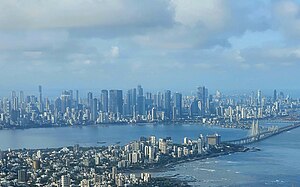
A | B | C | D | E | F | G | H | CH | I | J | K | L | M | N | O | P | Q | R | S | T | U | V | W | X | Y | Z | 0 | 1 | 2 | 3 | 4 | 5 | 6 | 7 | 8 | 9
 | |
| Currency | Indian rupee (INR, ₹) |
|---|---|
| 1 April – 31 March | |
Trade organisations | WTO, WCO, SAFTA, BIMSTEC, WFTU, BRICS, G-20, BIS, AIIB, ADB and others |
Country group | |
| Statistics | |
| Population | |
| GDP | |
| GDP rank | |
GDP growth | |
GDP per capita | |
GDP per capita rank | |
GDP by sector |
|
GDP by component |
|
| |
Population below poverty line | |
| |
Labour force | |
Labour force by occupation | |
| Unemployment | |
Final consumption expenditure | |
Gross capital formation | |
| Gross savings | 31.781% of GDP (2023)[30] |
| 10-year bond 7.190% (Jan 2023)[31][32] | |
Main industries | |
| External | |
| Exports | |
Export goods |
|
Main export partners |
|
| Imports | |
Import goods |
|
Main import partners |
|
FDI stock | |
Gross external debt |
|
| Public finances | |
| –6.4% of GDP (2022–23)[45] | |
| Revenues | |
| Expenses | |
| Economic aid |
|
(as of 17 May 2024) | |
All values, unless otherwise stated, are in US dollars. | |
The economy of India has transitioned from a mixed planned economy to a mixed middle-income developing social market economy with notable public sector in strategic sectors.[51] It is the world's fifth-largest economy by nominal GDP and the third-largest by purchasing power parity (PPP); on a per capita income basis, India ranked 136th by GDP (nominal) and 125th by GDP (PPP).[52] From independence in 1947 until 1991, successive governments followed the Soviet model and promoted protectionist economic policies, with extensive Sovietization, state intervention, demand-side economics, natural resources, bureaucrat driven enterprises and economic regulation. This is characterised as dirigism, in the form of the Licence Raj.[53][54] The end of the Cold War and an acute balance of payments crisis in 1991 led to the adoption of a broad economic liberalisation in India and indicative planning.[55][56] Since the start of the 21st century, annual average GDP growth has been 6% to 7%.[51]
Nearly 70% of India's GDP is driven by domestic consumption;[57] country remains the world's fourth-largest consumer market.[58] Apart from private consumption, India's GDP is also fueled by government spending, investments, and exports.[59] In 2022, India was the world's 8th-largest importer and the 10th-largest exporter.[60] India has been a member of the World Trade Organization since 1 January 1995.[61] It ranks 63rd on the Ease of doing business index and 40th on the Global Competitiveness Index.[62] With 476 million workers, the Indian labour force is the world's second-largest.[63] India has one of the world's highest number of billionaires and extreme income inequality.[64][65]
During the 2008 global financial crisis, the economy faced a mild slowdown. India endorsed Keynesian policy and initiated stimulus measures (both fiscal and monetary) to boost growth and generate demand. In subsequent years, economic growth revived.[66] The period between 2004 and 2014 is referred to as India's lost decade as India fell behind other BRIC economies.[67][68]
In 2021–22, the foreign direct investment (FDI) in India was $82 billion. The leading sectors for FDI inflows were the service sector, the computer industry, and the telecom industry.[69] India has free trade agreements with several nations and blocs, including ASEAN, SAFTA, Mercosur, South Korea, Japan, Australia, UAE, and several others which are in effect or under negotiating stage.[70][71]
The service sector makes up more than 50% of GDP and remains the fastest growing sector, while the industrial sector and the agricultural sector employs a majority of the labor force.[72] The Bombay Stock Exchange and National Stock Exchange are some of the world's largest stock exchanges by market capitalisation.[73] India is the world's sixth-largest manufacturer, representing 2.6% of global manufacturing output.[74] Nearly 65% of India's population is rural,[75] and contributes about 50% of India's GDP.[76] India faces high unemployment, rising income inequality, and a drop in aggregate demand.[77][78] India's gross domestic savings rate stood at 29.3% of GDP in 2022.[79] In recent years, independent economists and financial institutions have accused the government of manipulating various economic data, especially GDP growth rate.[80][81][82][83][84][85][86] India's overall social spending as a share of GDP in 2021–22 will be 8.6%, which is much lower than the average for OECD nations.[87][88]
Zdroj:https://en.wikipedia.org?pojem=Indian_economyText je dostupný za podmienok Creative Commons Attribution/Share-Alike License 3.0 Unported; prípadne za ďalších podmienok. Podrobnejšie informácie nájdete na stránke Podmienky použitia.
Antropológia
Aplikované vedy
Bibliometria
Dejiny vedy
Encyklopédie
Filozofia vedy
Forenzné vedy
Humanitné vedy
Knižničná veda
Kryogenika
Kryptológia
Kulturológia
Literárna veda
Medzidisciplinárne oblasti
Metódy kvantitatívnej analýzy
Metavedy
Metodika
Text je dostupný za podmienok Creative
Commons Attribution/Share-Alike License 3.0 Unported; prípadne za ďalších
podmienok.
Podrobnejšie informácie nájdete na stránke Podmienky
použitia.
www.astronomia.sk | www.biologia.sk | www.botanika.sk | www.dejiny.sk | www.economy.sk | www.elektrotechnika.sk | www.estetika.sk | www.farmakologia.sk | www.filozofia.sk | Fyzika | www.futurologia.sk | www.genetika.sk | www.chemia.sk | www.lingvistika.sk | www.politologia.sk | www.psychologia.sk | www.sexuologia.sk | www.sociologia.sk | www.veda.sk I www.zoologia.sk
